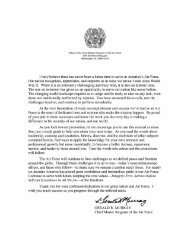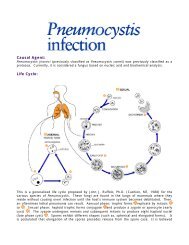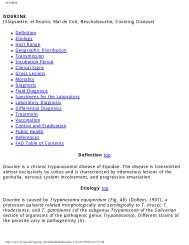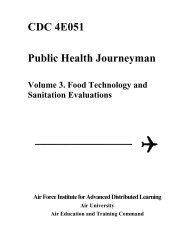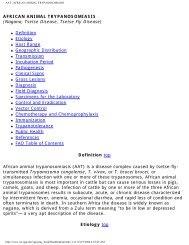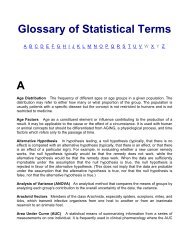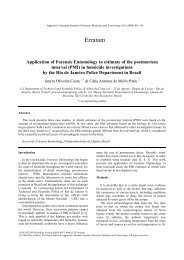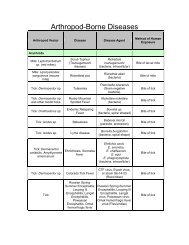AKABANE (Congenital arthrogryposis-hydranencephaly syndrome ...
AKABANE (Congenital arthrogryposis-hydranencephaly syndrome ...
AKABANE (Congenital arthrogryposis-hydranencephaly syndrome ...
Create successful ePaper yourself
Turn your PDF publications into a flip-book with our unique Google optimized e-Paper software.
<strong>AKABANE</strong><br />
<strong>AKABANE</strong><br />
(<strong>Congenital</strong> <strong>arthrogryposis</strong>-<strong>hydranencephaly</strong> <strong>syndrome</strong>, A-H <strong>syndrome</strong>, Akabane<br />
disease, congenital bovine epizootic A-H <strong>syndrome</strong>, acorn calves, silly calves, curly<br />
lamb disease, curly calf disease, dummy calf disease)<br />
●<br />
●<br />
●<br />
●<br />
●<br />
●<br />
●<br />
●<br />
●<br />
●<br />
●<br />
●<br />
●<br />
●<br />
●<br />
●<br />
●<br />
●<br />
●<br />
Definition<br />
Etiology<br />
Host Range<br />
Geographic Distribution<br />
Transmission<br />
Incubation Period<br />
Clinical Signs<br />
Gross Lesions<br />
Morbidity and Mortality<br />
Diagnosis<br />
Field Diagnosis<br />
Specimens for the Laboratory<br />
Laboratory Diagnosis<br />
Differential Diagnosis<br />
Vaccination<br />
Control and Eradication<br />
Public Health<br />
References<br />
FAD Table of Contents<br />
Definition top<br />
<strong>Congenital</strong> <strong>arthrogryposis</strong>-<strong>hydranencephaly</strong> (A-H) <strong>syndrome</strong> is an infectious<br />
disease of the bovine, caprine, and ovine fetus caused by intrauterine infection<br />
and interference with fetal development after transmission to the dam by biting<br />
gnat- or mosquito-transmitted Akabane virus and some other antigenically related<br />
members of the Simbu group of arboviruses (1,7). Fetal infection may cause<br />
abortions, stillbirths, premature births, mummified fetuses, and various<br />
dysfunctions or deformities of fetuses or liveborn neonates. Adult animals are not<br />
clinically affected while actively infected with virus (17).<br />
Etiology top<br />
http://www.vet.uga.edu/vpp/gray_book/Handheld/aka.htm (1 of 9)3/12/2004 3:57:08 AM
<strong>AKABANE</strong><br />
The etiologic agents of congenital A-H <strong>syndrome</strong> are arboviruses of the Simbu<br />
group of the family Bunyaviridae. Akabane virus was the first member of the<br />
Simbu group to be incriminated in congenital A-H <strong>syndrome</strong>, but other members<br />
(namely Aino, Peaton, and Tinaroo viruses) have the capacity to produce fetal<br />
defects (3,10,13,18). In recent years, Cache Valley virus, a mosquito-borne<br />
member of the Bunyaviridae outside the Simbu group, has been found to<br />
reproduce a similar <strong>syndrome</strong> in ruminants within the United States (2). The<br />
Simbu group of viruses are spread only by insect vectors. Spread by contact,<br />
infected tissues, exudates, or fomites does not occur.<br />
Host Range top<br />
<strong>Congenital</strong> A-H <strong>syndrome</strong> associated with Akabane virus and other Simbu group<br />
viruses has been reported only in cattle, sheep, and goats. Although antibody<br />
against these viruses has been detected in horses, no clinical evidence of fetal<br />
infection has been reported. Infections of wild ruminants do occur, and fetal<br />
damage must be considered but has not been reported.<br />
Geographic Distribution top<br />
In Japan, the periodic outbreaks of AH <strong>syndrome</strong> have been reported since 1949.<br />
Enzootic Akabane virus (and presumably other Simbu group virus) activity has<br />
occurred in the northern half of Australia since at least 1931 with occasional<br />
temporary epizootic incursions southward dependent on favorable seasons (18).<br />
Reports of A-H <strong>syndrome</strong> in Israel (8) and other countries in the Middle East,<br />
Cyprus (8,18,19), Korea, Zimbabwe, and South Africa have been published in the<br />
last decade. Serological surveys indicate that the virus occurs throughout Africa,<br />
Asia, and Australia but not Papua New Guinea, the Pacific Islands, or the<br />
Americas.<br />
Transmission top<br />
The occurrence of A-H <strong>syndrome</strong> is seasonally and geographically restricted. The<br />
location and timing of the infection of the fetus during early pregnancy is<br />
consistent with the seasonality of transmission by hematophagous insects.<br />
Akabane virus has been isolated from Aedes vexans and Culex triteeniorhynchus<br />
mosquitoes in Japan; Anopheles funestus mosquitoes in Kenya; Culicoides milnei<br />
and C. imicola in Africa; C. oxystoma in Japan; and C. brevitarsis and C. wadei<br />
gnats in Australia (3,13,17,18). Confirmation of the biologic transmission by these<br />
species is lacking; however, epidemiologic evidence incriminates them. In<br />
Australia, C. brevitarsis is believed to be the principal vector of Akabane virus.<br />
Cache Valley virus has been isolated from at least nine different mosquito species,<br />
http://www.vet.uga.edu/vpp/gray_book/Handheld/aka.htm (2 of 9)3/12/2004 3:57:08 AM
<strong>AKABANE</strong><br />
and antibodies to this virus have been detected in man, as well as wild and<br />
domestic animals in the Americas.<br />
There is no indication that Akabane virus, other Simbu group viruses or Cache<br />
Valley virus is transmitted in any other way than by a vector. Transmission<br />
happens months before disease in the fetus is evident.<br />
Incubation Period top<br />
Infection of adult animals produces no overt clinical sign, but viremia generally<br />
occurs 1-6 days after infection. A natural viremia may last 4 to 6 days before<br />
antibodies to Akabane virus are detectable (17). However, infection of pregnant<br />
animals during the first months of gestation may result in fetal infection that is not<br />
apparent until much later in pregnancy or at term (6).<br />
Timing of the infection relative to the stage of gestation is critical to the<br />
development of defects in the fetus. In pregnant sheep, the gestational period for<br />
the occurrence of fetal abnormalities has been shown to vary from 30-36 days to<br />
30-50 days (6,14,15). This variation in the reported results has been ascribed to<br />
(a) differences in the virulence of virus strains used, (b) differences in the passage<br />
level of the virus strain used, or (c) differences caused after growth of the virus in<br />
the arthropod vectors. Inoculation of pregnant cattle with virus between 62 and 96<br />
days of gestation resulted in fetal lesions; in pregnant goats, the critical period in<br />
the gestational cycle was about 40 days (10,12).<br />
Clinical Signs top<br />
<strong>Congenital</strong> A-H <strong>syndrome</strong> is manifested as a seasonally sporadic epizootic of<br />
abortions, stillbirths, premature births, and deformed or anomalous bovine,<br />
caprine, and ovine fetuses or neonates. The pregnant dam has no clinical<br />
manifestation at the time of infection with virus. Sentinel cattle under close<br />
observation have no clinical sign during viremia induced by natural infection. If<br />
infection develops during the first third of pregnancy, gross fetal damage may<br />
occur. At the other end of the disease spectrum, damage to the central nervous<br />
system (CNS) may be minor and produce changes in behavior of the new born or<br />
young animal. Dystocia at parturition may occur owing to the deformities in the<br />
fetus. Badly deformed fetuses are usually dead at birth, and the limbs are locked<br />
in the flexed or extended position. Most live neonates have central nervous system<br />
degeneration and muscle lesions that prevent the animal from standing or<br />
suckling. Torticollis, scoliosis, brachygnathism, and kyphosis may coexist with<br />
<strong>arthrogryposis</strong>. Lesions in the central nervous system are manifested clinically as<br />
blindness, nystagmus, deafness, dullness, slow suckling, paralysis, and<br />
http://www.vet.uga.edu/vpp/gray_book/Handheld/aka.htm (3 of 9)3/12/2004 3:57:08 AM
<strong>AKABANE</strong><br />
incoordination.<br />
Mildly affected calves or lambs may improve their mobility with time. However,<br />
most eventually die by 6 months as a result of blindness and other neurological<br />
defects (5,7,10,12,14,15,17).<br />
Gross Lesions top<br />
An individual fetus or newborn may have <strong>arthrogryposis</strong> and hydranecephaly or<br />
both <strong>syndrome</strong>s. Lesions are associated with damage to the enervation of the<br />
musculature and to the central nervous system. Arthrogryposis is the most<br />
frequently observed lesion. Affected joints cannot be straightened even by<br />
application of force because of ankylosis of the joint in the extended or flexed<br />
position (Fig. 23). Torticollis, scoliosis, and brachygnathism are observed. There<br />
may be shallow erosions about the external nares and muzzle and between the<br />
distal digits. Hypoplasia of the lungs and skeletal muscles, fibrinous polyarticular<br />
synovitis, fibrinous navel infection, ophthalmia, cataracts, and presternal steatosis<br />
occur. Within the CNS, <strong>hydranencephaly</strong> (Fig. 24), hydrocephalus, agenesis of the<br />
brain, microencephaly, porencephaly and cerebellar cavitation, fibrinous<br />
leptomeningitis, fibrinous ependymitis, and agenesis or hypoplasia of the spinal<br />
cord are variously reported (5, 16, 20). The cerebellum appears intact. Lesions<br />
due to Akabane tend to be symmetrical. However, some asymmetry occurs when<br />
Aino virus is involved. Akabane virus was isolated from fetuses of naturally<br />
infected pregnant cows or ewes by the use of predictive serology. When the<br />
mothers seroconverted from negative to positive in Akabane virus neutralization<br />
tests, Akabane virus was isolated from the fetus (4,11).<br />
Morbidity and Mortality top<br />
In endemic areas, animals are exposed and become immune before becoming<br />
pregnant; thus, congenital abnormalities are seldom seen in native animals, for<br />
antibodies prevent virus from spreading from the site of the bite to the fetus.<br />
However, when the infected vector spreads (e.g., during an extended humid<br />
summer) to an area where the animals are not immune, A-H <strong>syndrome</strong> can occur<br />
months later in many animals. The disease can also appear when pregnant<br />
animals from a disease-free area are moved into an endemic area.<br />
There is no reported damage to the dam in congenital A-H <strong>syndrome</strong>. Most liveborn<br />
affected calves, lambs, or kids die shortly after birth or must be slaughtered<br />
for humane reasons. Some mildly affected calves do improve gait and learn to<br />
follow the herd.<br />
http://www.vet.uga.edu/vpp/gray_book/Handheld/aka.htm (4 of 9)3/12/2004 3:57:08 AM
<strong>AKABANE</strong><br />
Diagnosis top<br />
Field Diagnosis<br />
A field diagnosis of congenital A-H <strong>syndrome</strong> can be made on the basis of the<br />
clinical condition, gross pathologic lesions, and the epidemiology. The sudden<br />
onset of aborted, mummified, premature, or stillborn fetuses with <strong>arthrogryposis</strong><br />
and <strong>hydranencephaly</strong> should be suggestive. The dam will have had no clinical<br />
history of disease. A retrospective study would indicate that the first third of<br />
pregnancy occurred during a time of biting insect activity.<br />
Specimens for the Laboratory top<br />
The following specimens should collected for virus isolation: placenta, fetal<br />
muscle, cerebrospinal fluid, and fetal nervous tissue; for serology: fetal or<br />
precolostral serum, and serum from the dam. For histopatholgy send pieces of<br />
spleen, liver, lung, kidney, heart, lymph nodes, affected muscle, spinal cord and<br />
brain in 10 percent buffered formalin.<br />
If the specimens can be delivered to a laboratory within 24 hours, they should be<br />
placed on ice. If delivery will take longer, quickfreeze the specimens and do not<br />
allow them to thaw during transit<br />
Laboratory Diagnosis top<br />
Virus isolation should be attempted from placenta, fetal muscle, or fetal nervous<br />
tissue. The chances of success are very low except with a fetus and placenta<br />
aborted before antibodies are generated within an immunocompetent fetus. In the<br />
absence of viral isolations, a serologic diagnosis is usually made by demonstrating<br />
antibodies in precolostral or fetal serum samples. In adult animals, seroconversion<br />
or a demonstrable rise in antibody titer indicates that there was infection. A<br />
microtiter neutralization test and an immunofluorescence test are available for<br />
detecting and assaying antibodies (18). Tissues of the dam are free of virus by the<br />
time the damage is observed in the fetus or newborn. Low titers (
<strong>AKABANE</strong><br />
essential to distinguish exotic from enzootic etiologies (2). It is a reasonable<br />
assumption that other Bunyaviridae will be proven to be teratogenic in livestock in<br />
the Americas. A variety of nutritional, genetic, toxic, and infectious diseases will<br />
produce fetal wastage and deformities. Fetal brain lesions resulting from<br />
bluetongue vaccine virus infections of pregnant ewes are similar to those produced<br />
within the congenital A-H <strong>syndrome</strong>. Bluetongue presents the greatest difficulty in<br />
the initial differential diagnosis of <strong>hydranencephaly</strong>. Bovine virus diarrhea infection<br />
can cause cerebellar dysplasia in calves. Border disease virus infection can cause<br />
undersized, excessively hairy lambs with muscular tremors and skeletal defects.<br />
Wesselsbron virus infection can cause congenital porencephaly and cerebral<br />
hypoplasia in calves. Serology of the dam and fetus will resolve any confusion.<br />
Vaccination top<br />
A formalin-inactivated, aluminum phosphate, gel-absorbed vaccine and an<br />
attenuated vaccine have been developed in Japan for Akabane virus. An effective<br />
killed vaccine for Akabane virus has been developed but not marketed in Australia<br />
(7,9). These vaccines induce immunity in the cow or ewe, and the circulating<br />
antibodies prevent the virus from reaching the fetus. The vaccines are used prior<br />
to exposure to infected vectors. Vaccine is no longer available for economic<br />
reasons. Immunizing agents for other Simbu group viruses are not currently<br />
available and are not expected to be developed.<br />
Control and Eradication top<br />
Techniques for the control of the viral agents that cause congenital A-H <strong>syndrome</strong><br />
are those typically recommended for other vector-transmitted agents. Control of<br />
the vector depends upon disruption of breeding sites, reduction of vector<br />
populations with pesticides, and protection of host animals from feeding by the<br />
vectors. In addition to these procedures, animals should be vaccinated before<br />
breeding.<br />
Public Health top<br />
There is no evidence that humans can be infected by Akabane virus.<br />
GUIDE TO THE LITERATURE top<br />
1. COVERDALE, O. R., CYBINSKI, D. H., and ST. GEORGE, T. D. 1979. A study of<br />
the involvement of three Simbu group arboviruses in bovine congenital<br />
<strong>arthrogryposis</strong> and <strong>hydranencephaly</strong> in the New England area of New South<br />
Wales. Proc. 2d Symp. Arbovirus Res. Austral., 2:130-139.<br />
http://www.vet.uga.edu/vpp/gray_book/Handheld/aka.htm (6 of 9)3/12/2004 3:57:08 AM
<strong>AKABANE</strong><br />
2. CHUNG, S. I., LIVINGSTON, C. W., EDWARDS, J. F., GAUER, B. B., and<br />
COLLISSON, E. W. 1990. <strong>Congenital</strong> malformations in sheep resulting from in<br />
utero inoculation of Cache Valley virus. Am. J. Vet. Res., 51:1645-1648.<br />
3. CYBINSKI, D. H., and MULLER, M. J. 1990. Isolation of arboviruses from cattle<br />
and insects at two sentinel sites in Queensland, Australia, 1979-85. Aust. J. Zool.,<br />
38:25-32.<br />
4. DELLA-PORTA, A. J., O'HALLORAN, M. L., PARSONSON, M., SNOWDON, W. A.,<br />
MURRAY, M. D., HARTLEY, W. J.. and HAUGHEY, K. J. 1977. Akabane disease:<br />
Isolation of the virus from naturally infected ovine foetuses. Austral. Vet. J., 53:51-<br />
52.<br />
5. HARTLEY, W. J., de SARAM, W. G., DELLA-PORTA, A. J., SNOWDON, W. A., and<br />
SHEPHERD, N. C. 1977. Pathology of congenital bovine epizootic <strong>arthrogryposis</strong><br />
and <strong>hydranencephaly</strong> and its relationship to Akabane virus. Austral. Vet. J..<br />
53:319-325.<br />
6. HASHINGUCHI, Y., NANBA, K., and KUMAGAI, T. 1979. <strong>Congenital</strong><br />
abnormalities in newborn lambs following Akabane virus infection in pregnant<br />
ewes. Natl. Inst. Anim. Hlth. Q. (Tokyo), 19:1-11.<br />
7. INABA, Y., and MATUMOTO, M. 1981. <strong>Congenital</strong> Arthrogryposis-<br />
Hydranencephaly Syndrome, in Virus Diseases of Food Animals. Vol. II: Disease<br />
Monographs, E. P. J. Gibbs, ed. San Francisco: Academic Press, pp. 653-671.<br />
8. KALMAR, E., PELEG, B. A., and SAVIR, D. 1975. Arthrogryposis<strong>hydranencephaly</strong><br />
<strong>syndrome</strong> in newborn cattle, sheep and goats -Serological<br />
survey for antibodies against the Akabane virus. Refuah Vet., 32:47-54.<br />
9. KIRKLAND, P. D., and BARRY, R. D. 1986. The economic impact of Akabane<br />
virus and the cost effectiveness of vaccination in New South Wales. Proc. 4th<br />
Symp. Arbovirus Res. Austral., 4:229-232.<br />
10. KUROGI, H., INABA, Y., TAKAHASHI, E., SATO, K., GOTO, Y., and OMORI, T.<br />
1977. Experimental infection of pregnant goats with Akabane virus. Nat. Inst.<br />
Anim. Hlth Q. (Tokyo), 16:1-9.<br />
11. KUROGI, H., INABA, Y., TAKAHASHI, E., SATO, K., OMORI, T., MIURA, T.,<br />
GOTO, Y., FUJIWARA, Y., HATANO, Y., KODAMA, K., FUKUYAMA, S., SASAKI, N.,<br />
and MATUMOTO, M. 1976. Epizootic congenital <strong>arthrogryposis</strong>-<strong>hydranencephaly</strong><br />
http://www.vet.uga.edu/vpp/gray_book/Handheld/aka.htm (7 of 9)3/12/2004 3:57:08 AM
<strong>AKABANE</strong><br />
<strong>syndrome</strong> in cattle: Isolation of Akabane virus from affected fetuses. Arch. Virol.,<br />
51:5674.<br />
12. KUROGI, H., INABA, Y., TAKAHASHI, E., SATO, K., SATODA, K., GOTO, Y.,<br />
OMORI, T., and MATUMOTO, M. 1977. <strong>Congenital</strong> abnormalities in newborn calves<br />
after inoculation of pregnant cows with Akabane virus. Infect. Immun., 17:338-<br />
343.<br />
13. McPHEE, D. A., PARSONSON, I. M., and DELLA-PORTA, A. J. 1982.<br />
Development of a chicken embryo model for testing the teratogenic potential of<br />
Australian bunyaviruses. Proc. 3d Symp. Arbovirus Res. Austral., 3:127-134.<br />
14. PARSONSON, I.M., DELLA-PORTA, A. J., and SNOWDON, W.A. 1977.<br />
<strong>Congenital</strong> abnormalities in newborhn lambs after infection of pregnant sheep with<br />
Akabane virus. Infect. Immun., 15:254-262.<br />
15. PARSONSON, I.M., DELLA-PORTA, A. J., and SNOWDON, W.A. 1981.<br />
Developmental disorders of the fetus in some arthropod-borne virus infections.<br />
Am. J. Trop. Med. Hyg., 30:660-673.<br />
16. PARSONSON, I.M., DELLA-PORTA, A. J., and SNOWDON, W.A. 1981. Akabane<br />
virus infection in the pregnant ewe. 2. Pathology of the foetus. Vet. Microbiol.,<br />
6:209-224.<br />
17. ST. GEORGE, T.D., STANDFAST, H.A., and CYBINSKI, D.H. 1978. Isolations of<br />
Akabane virus from sentinel cattle and Culicoides brevitarsis. Austral. Vet. J.,<br />
54:558-561.<br />
18. ST. GEORGE, T.D., and STANDFAST, H.A. 1989. Simbu Group Viruses with<br />
Teratogenic Potential, in The Arboviruses: Epidemiology and Ecology lV, T.P.<br />
Monath, ed. Boca Raton, Fl.: CRC Press, pp. 145-166.<br />
19. SELLERS, R.F., and HERNIMAN, K.J. 1981. Neutralizing antibodies to Akabane<br />
virus in ruminants in Cyprus. Trop. Anim. Hlth. Prod., 13: 57-60.<br />
20. WHITTEM, J. H. 1957. <strong>Congenital</strong> abnormalities in calves: <strong>arthrogryposis</strong> and<br />
<strong>hydranencephaly</strong>. J. Pathol. Bacteriol., 73:375-387.<br />
T. D. St. George, D.V.Sc., 15 Tamarix St., Chapel Hill, Queensland 4069, Australia<br />
http://www.vet.uga.edu/vpp/gray_book/Handheld/aka.htm (8 of 9)3/12/2004 3:57:08 AM
<strong>AKABANE</strong><br />
http://www.vet.uga.edu/vpp/gray_book/Handheld/aka.htm (9 of 9)3/12/2004 3:57:08 AM



